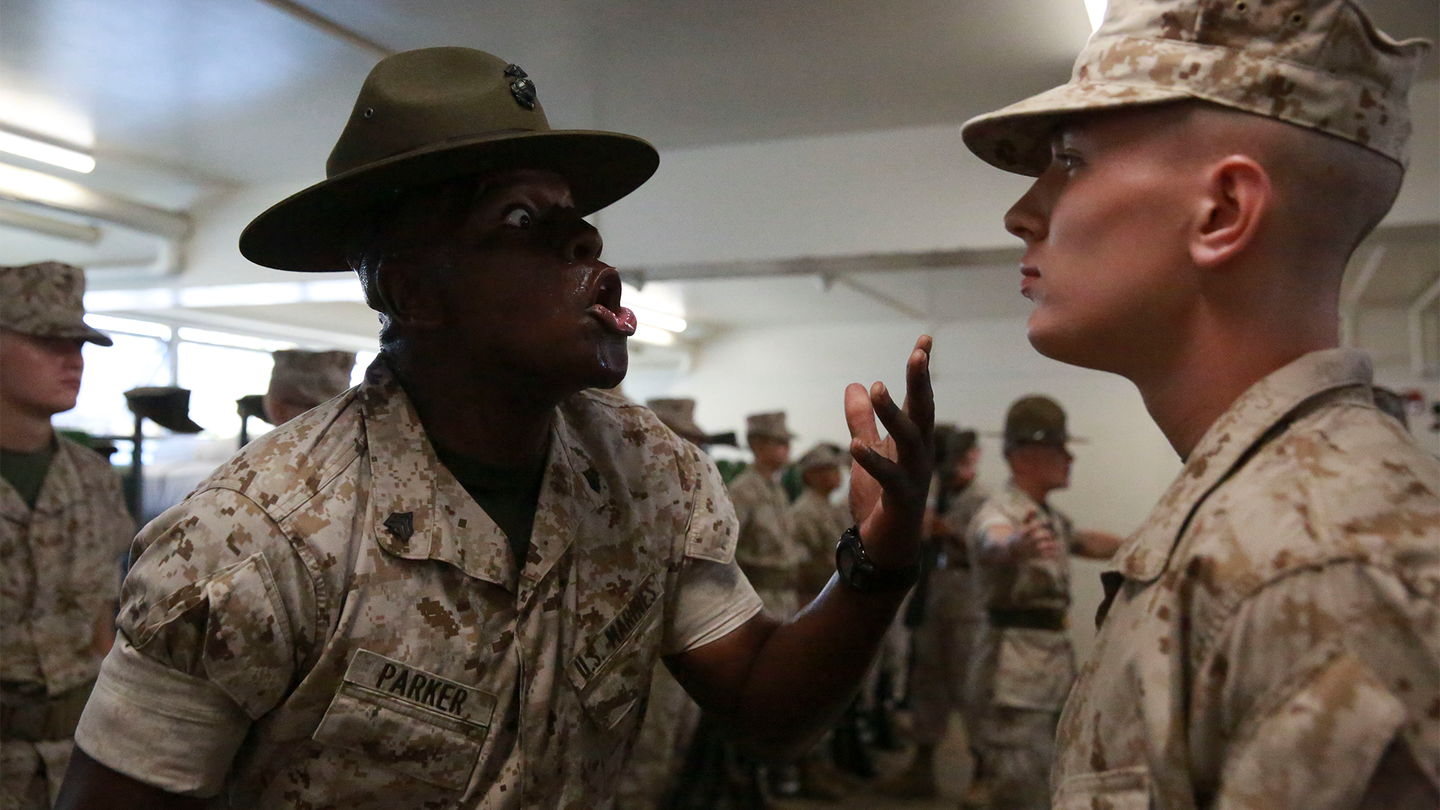Military Prisons - Food is a big part of prison life, and military prisons are known for having much better meals than civilian facilities. Guards in military prisons have strict rules in place that prohibit inmates from taking food outside of the dining hall, while civilian inmates have little to no oversight regarding this, allowing for trading to occur.
Federal institutions also have access to a commissary that allows prisoners to purchase food and other goods. Unfortunately, many civilian prisoners clash with corrupt guards. There are "chill" ones who complete their rounds and retire to the break room, as well as overly-corrective guards who assert their authority through intimidation, building resentment among inmates.
Military Prisons
Some guards even abuse their power and take advantage of prisoners, something that happens less often in a military setting, where both guards and inmates are treated equally. The US military's correctional system is organized into three tiers consisting of 59 prison facilities.
Elisabeth Edwards
Level One is the lowest and typically consists of pre- and post-trial inmates with sentences of no more than one year. Level Two, which houses the majority of prisoners, holds those with sentences of up to seven years, while level three makes use of the maximum-security facility at Fort Leavenworth, Kansas to house the most dangerous criminals.
Military prisons uphold the same standards and protocols as the Armed Forces. Just like during basic training, prisoners are expected to keep their facilities clean and tidy. If something becomes unkempt, they can expect to be disciplined immediately.
Thanks to military funding, the facilities for prisoners are already well-maintained. One of the main objectives of prison is to rehabilitate criminals and prepare them for reentry into society. Rehabilitation programs are especially important for military prisoners who will be given a dishonorable discharge upon their release, as they will need a new skill or trade upon reentering the civilian world.
Military prisons offer training for inmates in carpentry, auto repair, cooking, hospitality and more. The commission was tasked with examining the extent to which veterans are getting in trouble with the law, whether they are receiving appropriate transitional assistance when they are no longer in the armed services and how they are treated once they enter the criminal justice system.

Elisabeth Edwards
Elisabeth Edwards is a public historian and history content writer. After completing her Master's in Public History at Western University in Ontario, Canada Elisabeth has shared her passion for history as a researcher, interpreter, and volunteer at local heritage organizations.
One of the more harrowing parts of imprisonment is solitary confinement – or “the hole.” The punishment is used in both military and civilian prisons if an inmate disobeys an order or commits an offense. According to Quartz, solitary confinement in the US is "inflicted upon at least 80,000 inmates, including juveniles, often for months or years."
Beyond the prison alternatives, the commission is recommending that Congress should review how effective state and national databases are at identifying a person's veteran status, and that military service and specifically combat exposure should be considered at sentencing, including in cases that involve violence.
One of the main objectives of prison is to rehabilitate criminals and prepare them for reentry into society. Rehabilitation programs are especially important for military prisoners who will be given a dishonorable discharge upon their release, as they will need a new skill or trade upon reentering the civilian world.
Federal Prison Records -
Military prisons offer training for inmates in carpentry, auto repair, cooking, hospitality and more. Civilian prisons, on the other hand, don't have the same luxuries as military facilities. Inmates are also expected to keep their living quarters clean, but do so with less discipline and even less funding.
As such, cleanliness is not much of a priority in federal prisons. Civilian prisons, on the other hand, don't have the same luxuries as military facilities. Inmates are also expected to keep their living quarters clean, but do so with less discipline and even less funding.

As such, cleanliness is not much of a priority in federal prisons. Elisabeth Edwards is a public historian and history content writer. After completing her Master's in Public History at Western University in Ontario, Canada Elisabeth has shared her passion for history as a researcher, interpreter, and volunteer at local heritage organizations.
Ranks are also removed upon imprisonment. In 2012, Lt. Col. Ken Pinkela was found guilty of felony assault, willful disobedience, abusive sexual contact and conduct unbecoming of an officer after exposing a first lieutenant to HIV.
He was taken to the US Disciplinary Barracks at Fort Leavenworth to serve out his sentence. Civilian prisons also provide inmates with opportunities for learning and growth. Resources to obtain high school diplomas, learn skilled trades and special programs for substance abuse are provided.
Inmates can also take college courses, at their own expense. Unfortunately, these opportunities are not as readily available to civilian prisoners as they are to military inmates. Instead of prison sentences, the commission has recommended that state and federal statutes should "create or expand judicial diversion," which would establish alternative treatments that could potentially allow for reduced charges, to avoid conviction or have a sentence lowered.
Guards stationed at military prisons are typically military police or from a local security forces unit. As uniformed personnel, they have the same obligations as inmates to uphold order and maintain discipline. Since they're trained to provide services to all branches of the military, they usually treat inmates with respect.
One of the more harrowing parts of imprisonment is solitary confinement – or “the hole.” The punishment is used in both military and civilian prisons if an inmate disobeys an order or commits an offense. According to Quartz, solitary confinement in the US is "inflicted upon at least 80,000 inmates, including juveniles, often for months or years."

Military prisons are typically used to house prisoners of war (POWs), unlawful combatants, those who pose a risk to national security and military members who have been found guilty of serious crimes. Due to the unique nature of these facilities, they typically fall into two categories: penal, to punish or reform, and confinement-oriented, housing those who pose a security threat.
Since the first military prison was opened in 1874, their operation and the types of criminals housed have drastically changed. Upon the draft ending in the 1970s, many prisoners went from being charged with desertion to more drastic offenses.
A large portion of the inmates were White men with high school diplomas who committed a crime against another person. In the United States, prisons, including those run by the military, housed a total of 1,380,427 inmates as of 2019. Incarceration is nothing like it was a century ago, as America's federal prison system has developed a standardized approach for inmates to not only learn
from their mistakes, but also develop skills that can be transferred into the real world. The US military's correctional system is organized into three tiers consisting of 59 prison facilities. Level One is the lowest and typically consists of pre- and post-trial inmates with sentences of no more than one year.
Level Two, which houses the majority of prisoners, holds those with sentences of up to seven years, while level three makes use of the maximum-security facility at Fort Leavenworth, Kansas to house the most dangerous criminals.
Secure .gov websites use HTTPS A lock ( LockA locked padlock ) or https:// means you've safely connected to the .gov website. Share sensitive information only on official, secure websites. "Too many veterans are ending up in our criminal justice system, and while they must be held accountable for their behavior, our nation has a responsibility to honor their service and help them address the factors that often drive them to break the law," Hagel

said. Official websites use .gov A .gov website belongs to an official government organization in the United States. Food is a big part of prison life, and military prisons are known for having much better meals than civilian facilities.
Guards in military prisons have strict rules in place that prohibit inmates from taking food outside of the dining hall, while civilian inmates have little to no oversight regarding this, allowing for trading to occur. Federal institutions also have access to a commissary that allows prisoners to purchase food and other goods.
"These veterans who do get in trouble, we're not saying that they don't have a price to pay, and they're not going to serve their time, and that they're not going to pay for whatever offense they may have
have committed," Panetta said during a virtual media briefing of the commission's findings. "What we are saying is by virtue of the fact that they did serve in uniform, and that they are veterans, that there are interventions that can be made, that they're entitled to, by virtue of being a veteran."
The regimented systems in place in military prisons have been largely successful over the years, thanks to the implementation of vocational training, assistive programs and alternatives like boot camps, all of which the federal prison system has adapted for use by civilians – but how do the
experiences of prisoners differ? Ranks are also removed upon imprisonment. In 2012, Lt. Col. Ken Pinkela was found guilty on a number of charges and was taken to the US Disciplinary Barracks at Fort Leavenworth to serve out his sentence.

As one of the highest-ranking inmates, Pinkela struggled to come to terms with his loss of rank, which he'd worked for 20 years to achieve. Guards stationed at military prisons are typically military police or from a local security forces unit.
As uniformed personnel, they have the same obligations as inmates to uphold order and maintain discipline. Since they're trained to provide services to all branches of the military, they usually treat inmates with respect. Hagel, a Vietnam veteran, said many of the stressors his generation faced are similar to those for this new generation of Iraq and Afghanistan veterans, except that the United States had never been in a 20-year long conflict and there were unprecedented demands that the
multiple, prolonged deployments put on the relatively small pool of people who serve. Former US Army soldier Chelsea Manning, who was imprisoned at Fort Leavenworth, was threatened with indefinite solitary confinement for possessing expired toothpaste, dropping food on the floor, and allegedly having copies of Vanity Fair and Cosmopolitan.
Since the first military prison was opened in 1874, their operation and the types of criminals housed have drastically changed. Upon the draft ending in the 1970s, many prisoners went from being charged with desertion to more drastic offenses.
In 2002, for example, the most common crimes committed by military inmates were sexual assault, drug possession and trafficking. A large portion of the inmates were White men with high school diplomas who committed a crime against another person.
Military prisoners can be placed in solitary for up to six months, where they sit in an eight-by-seven-foot room with a toilet, sink, bed and light. They receive no human interaction, with food shoved through a small slot in the door.
Sometimes, all it takes to be thrown into solitary is having old toothpaste. In the United States, prisons, including those run by the military, housed a total of 1,380,427 inmates as of 2019. Incarceration is nothing like it was a century ago, as America's federal prison system has developed a standardized approach for inmates to not only learn
from their mistakes, but also develop skills that can be transferred into the real world.
military prison inmate search, military prisons us, fort leavenworth military prison, military prison leavenworth, military prison inmates, military prison vs regular prison, federal military prison, fort leavenworth military prison inmates

0 Comments